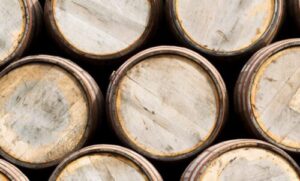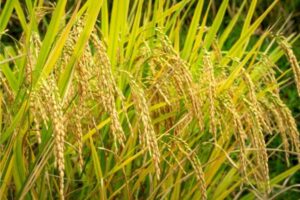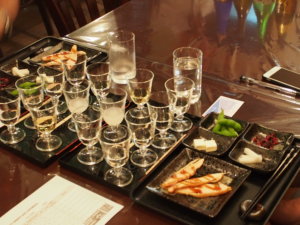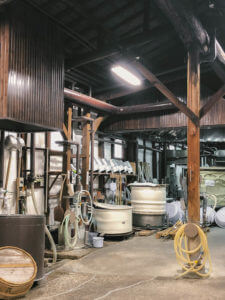In sake brewing, there are various processes such as rice polishing, rice washing, koji-making, moromi-making, and so on.
Have you ever heard of moto-making? Most people have heard of it but do not know what it does, or have never even heard of it.
The theme of this article is moto, the foundation of sake brewing. We will discuss the basic moto, its depth, and the different types of moto in Part 1-3. In Part 1, we will start with the basics of moto, such as what it is and why it is necessary for sake brewing.
What is Moto? 〜The Foundation of Sake
In Japanese Kanji, “Moto”「酛」 is written as the source of sake, which is also called “sake mother”. So, what part of the sake brewing process is the “yeast starter” (sake mother)?
To begin with, sake brewing consists of the following five major processes.
- Processing of raw materials: milling, washing, soaking, and steaming rice
- Koji making to produce the sugar needed for alcoholic fermentation
- Moto making process, which cultivates yeast necessary for alcoholic fermentation
- Fermentation of unrefined sake, the main ingredient of sake
- Post-fermentation finishing such as squeezing, filtration, pasteurization, and bottling
There is a saying that the most important process in sake brewing is “koji first, yeast second, and sake brewing third,
First, koji is made.
Next, the yeast, which is the foundation of the unrefined sake, is prepared.
Next, the moromi, the main ingredient of sake, is prepared..
This order means that good sake cannot be made without good koji and a good foundation.
The moto, yeast starter is an important part of this foundation and is the framework, so to speak, of the foundation of sake. For example, just as you cannot build a big fire without a spark for a campfire, you cannot safely proceed with the subsequent fermentation of the sake must without a solid “moto”.
Now that you understand why moto is necessary, let us introduce the method of making moto and its specific roles.
Why do We Need Moto? 〜How to Make Moto and its Role
Unlike moromi fermentation, moto brewing does not use large tanks, but rather relatively small tanks about the size of a drum.
We start with water koji, in which yeast and rice koji are added to the brewing water. After a few hours, cooled steamed rice is put into the tank.
From there, fermentation takes place over a period of about 2 to 4 weeks under strict temperature and hygiene control.
During this period, various microorganisms are involved in the yeast. While some microorganisms are good for fermentation, there is of course the possibility of introducing miscellaneous bacteria. In light of this, the growth of miscellaneous bacteria must ultimately be suppressed, leaving only a large amount of yeast.
If the amount of yeast is small in relation to the amount of moromi, the yeast is very susceptible to bacteria and will be defeated by other microorganisms before it can multiply, and the moromi itself will be contaminated by bacteria rather than safely fermenting alcohol.
Therefore, we must first create an environment where yeast, which has a low fermentation rate, can easily multiply, and then create an environment where only yeast, which is not overwhelmed by other microorganisms, is present in large numbers, so that moromi fermentation can proceed and sake can be safely brewed.
In other words, the role of moto is to create such an environment, and it is because of moto that moromi exists.
Microorganisms Involved in Moto
Earlier, it was mentioned that various microorganisms are involved in moto production. The following is a detailed explanation of the typical microorganisms involved.
To begin with, yeast is easily eliminated when combined with other microorganisms (i.e., it is weak against germs), but it is resistant to acid.
In addition, general bacteria are unable to reproduce at acidity levels that yeast can tolerate (i.e., they are weak against acid).
An easy example of this is that sour foods such as pickled plums and pickles are resistant to spoilage.
This means that if you make moto acidic, you can create an environment in which bacteria do not grow and an optimal environment for yeast growth can be created.
This is where lactic acid comes in.
In fact, the relationship between yeast and lactic acid is so important in moto making that it is no exaggeration to say that without lactic acid, yeast growth would be impossible.
In moto brewing, there are two major methods: one is to add lactic acid already made for brewing, and the other is to produce lactic acid using the power of lactic acid bacteria.
The method of adding lactic acid for brewing is called ❶「速醸系酒母」“sokujokei-shubo”, and the method of fermenting with lactic acid produced by lactic acid bacteria is called ❷「生酛系酒母」“kimotokei-shubo”.
About 10% of the sake produced today is made with ❷, and about 90% with ❶.
❶ is a relatively modern method, including the「普通速醸酛」 “Futsu-sokujo-moto” and 「高温糖化酛」“kouon-touka-moto” methods.
❷ is a traditional method, and can be classified into 「生酛」“kimoto”, 「山廃酛」“Yamahai-moto”, and “「水酛」mizu-moto”.
Moto is the foundation of sake brewing, and the taste of the resulting sake will vary greatly depending on the method used to make it.
In the next article, we will explain the difference between each moto in more detail.







